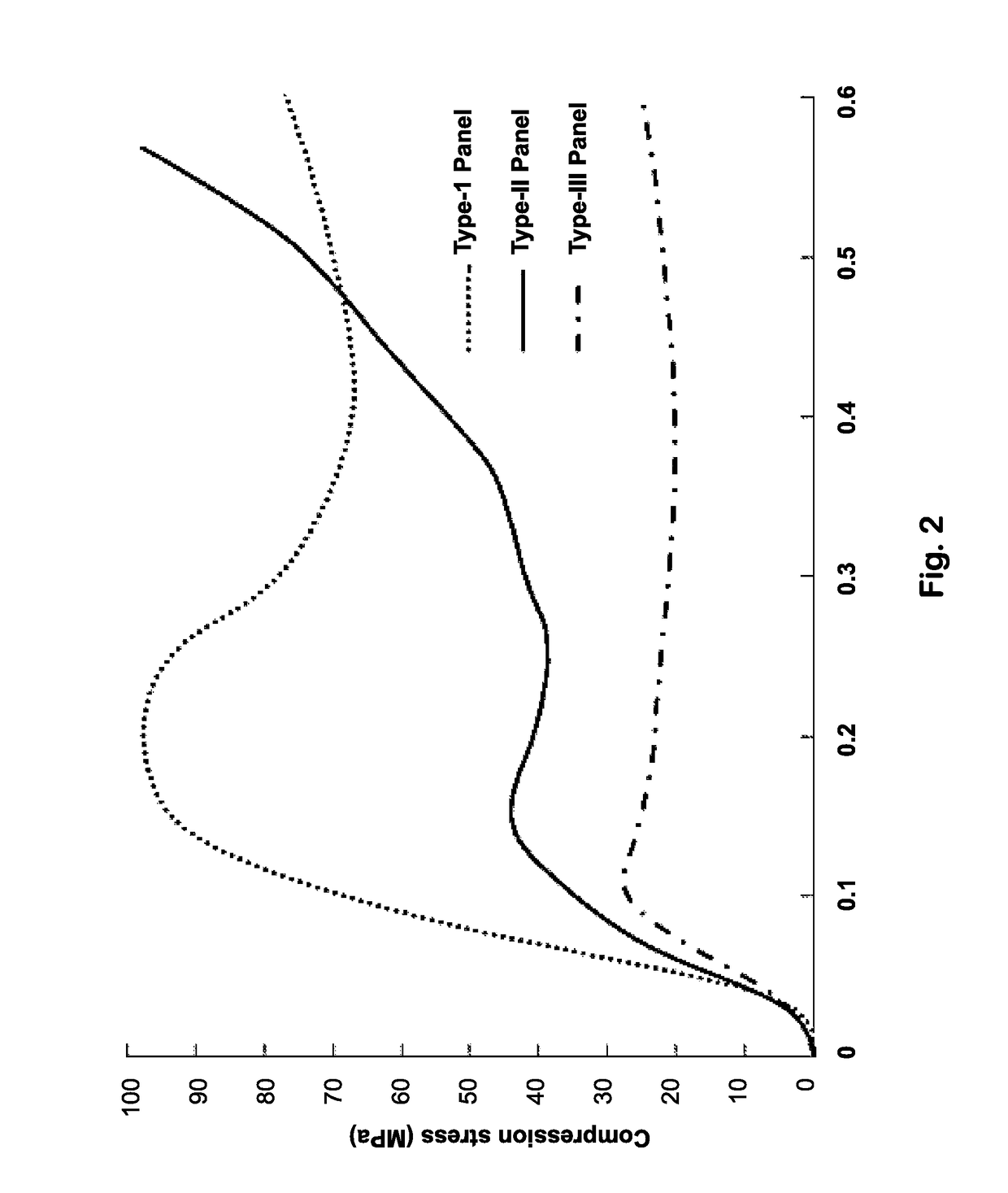Sandwich panel with a ductile hybrid core comprising tubular reinforcements
a technology of tubular reinforcement and hybrid core, applied in the field of structural materials, can solve the problems of sudden loss of structural integrity, catastrophic consequences, and inability to fully exploit the capabilities of sandwich panels in critical structural applications, and achieve the effect of simple implementation and convenient mass production
- Summary
- Abstract
- Description
- Claims
- Application Information
AI Technical Summary
Benefits of technology
Problems solved by technology
Method used
Image
Examples
example 1
n of Sandwich Panels with Either in-Plane or Out-of-Plane Metal Tube Reinforced Foam Core
[0075]In this example, two types of hybrid cores and one traditional syntactic foam core were evaluated. The first hybrid core consisted of vertically (transverse relative to the surface plane) aligned metallic millitubes and polymer resin, which was denoted by type-I core (the corresponding sandwich panel was denoted by type-I panel). The type-I core is illustrated in FIG. 1a. The second hybrid core consisted of horizontally (in-plane with that of the surface) aligned metallic millitubes and polymer resin which was denoted by type-II core (the corresponding sandwich panel was denoted by type-II panel). The type-II core is shown in FIG. 1b. A traditional syntactic foam core (glass microballoon based) was selected as the reference, denoted as type-III core (the corresponding sandwich was denoted by type-III panel). The type-III core is plotted in FIG. 1c.
[0076]Materials
[0077]The face sheets of a...
example 2
Panels with Metal Tube Grid as Reinforcement of a Foam Core
[0103]In this example, a type-II panel embodiment comprising a metallic millitube grid that reinforces a polymer cored sandwich panel is set forth. The new core of this Example is a hybrid core comprising hollow metallic millitubes in the form of a grid. This differed from the type-II core embodiment of Example I in that the core here comprised a polymer resin reinforced by metallic millitubes which are now in a grid configuration rather than all millitubes in parallel as in Example 1. Low velocity impact testing demonstrated that the new grid panel is an option for critical structural applications where features such as debonding resistance and multiple impact tolerance are important.
[0104]It was found that by filling the empty bays in the grid skeleton with syntactic foam (the same polymer resin as in Example 1), the resulting composite sandwich was an advantageous structure for impact mitigation because (1) each cell is a...
example 3
Panels with in-Plane Metal Tube Reinforced Shape Memory Polymer (SMP) Foam Core
[0130]This example sets forth and characterizes a new sandwich panel which comprises a hybrid core with a metallic microtube-reinforced shape memory polymer matrix (rather than the polymer resin used in Example 2). Otherwise, this embodiment is generally analogous to the grid-stiffened embodiment set forth in Example 2. In addition, here aluminum tubes were used because: they are (1) lighter than steel tubes; and (2) to exemplify that ductile, strong yet light structural reinforcing units are efficacious regardless of the types of unit or tube material used.
[0131]Materials
[0132]The shape memory polymer was synthesized by using polytetramethylene ether glycol (Sigma-Aldrich, St. Louis, Mo.) as the soft segment while diphenylmethane-4,4-diisocyanate (MDI) (Sigma-Aldrich, St. Louis, Mo.) and molecular extender 1,4-butanediol (BDO) (Acros Organics, New Jersey) as the hard segment. polytetramethylene ether gly...
PUM
| Property | Measurement | Unit |
|---|---|---|
| elastic modulus | aaaaa | aaaaa |
| ultimate tensile strength | aaaaa | aaaaa |
| diameter | aaaaa | aaaaa |
Abstract
Description
Claims
Application Information
 Login to View More
Login to View More - R&D
- Intellectual Property
- Life Sciences
- Materials
- Tech Scout
- Unparalleled Data Quality
- Higher Quality Content
- 60% Fewer Hallucinations
Browse by: Latest US Patents, China's latest patents, Technical Efficacy Thesaurus, Application Domain, Technology Topic, Popular Technical Reports.
© 2025 PatSnap. All rights reserved.Legal|Privacy policy|Modern Slavery Act Transparency Statement|Sitemap|About US| Contact US: help@patsnap.com



